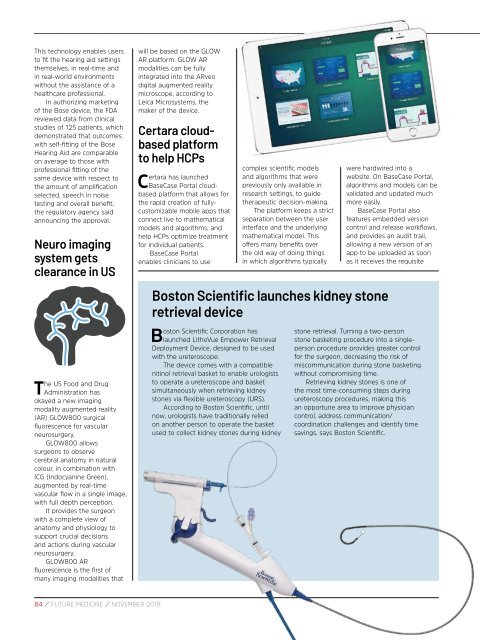Create successful ePaper yourself
Turn your PDF publications into a flip-book with our unique Google optimized e-Paper software.
This technology enables users<br />
to fit the hearing aid settings<br />
themselves, in real-time and<br />
in real-world environments<br />
without the assistance of a<br />
healthcare professional.<br />
In authorizing marketing<br />
of the Bose device, the FDA<br />
reviewed data from clinical<br />
studies of 125 patients, which<br />
demonstrated that outcomes<br />
with self-fitting of the Bose<br />
Hearing Aid are comparable<br />
on average to those with<br />
professional fitting of the<br />
same device with respect to<br />
the amount of amplification<br />
selected, speech in noise<br />
testing and overall benefit,<br />
the regulatory agency said<br />
announcing the approval.<br />
Neuro imaging<br />
system gets<br />
clearance in US<br />
The US Food and Drug<br />
Administration has<br />
okayed a new imaging<br />
modality augmented reality<br />
(AR) GLOW800 surgical<br />
fluorescence for vascular<br />
neurosurgery.<br />
GLOW800 allows<br />
surgeons to observe<br />
cerebral anatomy in natural<br />
colour, in combination with<br />
ICG (Indocyanine Green),<br />
augmented by real-time<br />
vascular flow in a single image,<br />
with full depth perception.<br />
It provides the surgeon<br />
with a complete view of<br />
anatomy and physiology to<br />
support crucial decisions<br />
and actions during vascular<br />
neurosurgery.<br />
GLOW800 AR<br />
fluorescence is the first of<br />
many imaging modalities that<br />
will be based on the GLOW<br />
AR platform. GLOW AR<br />
modalities can be fully<br />
integrated into the ARveo<br />
<strong>digital</strong> augmented reality<br />
microscope, according to<br />
Leica Microsystems, the<br />
maker of the device.<br />
Certara cloudbased<br />
platform<br />
to help HCPs<br />
Certara has launched<br />
BaseCase Portal cloudbased<br />
platform that allows for<br />
the rapid creation of fullycustomizable<br />
mobile apps that<br />
connect live to mathematical<br />
models and algorithms, and<br />
help HCPs optimize treatment<br />
for individual patients.<br />
BaseCase Portal<br />
enables clinicians to use<br />
Boston Scientific launches kidney stone<br />
retrieval device<br />
Boston Scientific Corporation has<br />
launched LithoVue Empower Retrieval<br />
Deployment Device, designed to be used<br />
with the ureteroscope.<br />
The device comes with a compatible<br />
nitinol retrieval basket to enable urologists<br />
to operate a ureteroscope and basket<br />
simultaneously when retrieving kidney<br />
stones via flexible ureteroscopy (URS).<br />
According to Boston Scientific, until<br />
now, urologists have traditionally relied<br />
on another person to operate the basket<br />
used to collect kidney stones during kidney<br />
complex scientific models<br />
and algorithms that were<br />
previously only available in<br />
research settings, to guide<br />
therapeutic decision-making.<br />
The platform keeps a strict<br />
separation between the user<br />
interface and the underlying<br />
mathematical model. This<br />
offers many benefits over<br />
the old way of doing things<br />
in which algorithms typically<br />
were hardwired into a<br />
website. On BaseCase Portal,<br />
algorithms and models can be<br />
validated and updated much<br />
more easily.<br />
BaseCase Portal also<br />
features embedded version<br />
control and release workflows,<br />
and provides an audit trail,<br />
allowing a new version of an<br />
app to be uploaded as soon<br />
as it receives the requisite<br />
stone retrieval. Turning a two-person<br />
stone basketing procedure into a singleperson<br />
procedure provides greater control<br />
for the surgeon, decreasing the risk of<br />
miscommunication during stone basketing<br />
without compromising time.<br />
Retrieving kidney stones is one of<br />
the most time-consuming steps during<br />
ureteroscopy procedures, making this<br />
an opportune area to improve physician<br />
control, address communication/<br />
coordination challenges and identify time<br />
savings, says Boston Scientific.<br />
84 / FUTURE MEDICINE / <strong>NOVEMBER</strong> <strong>2018</strong>


















